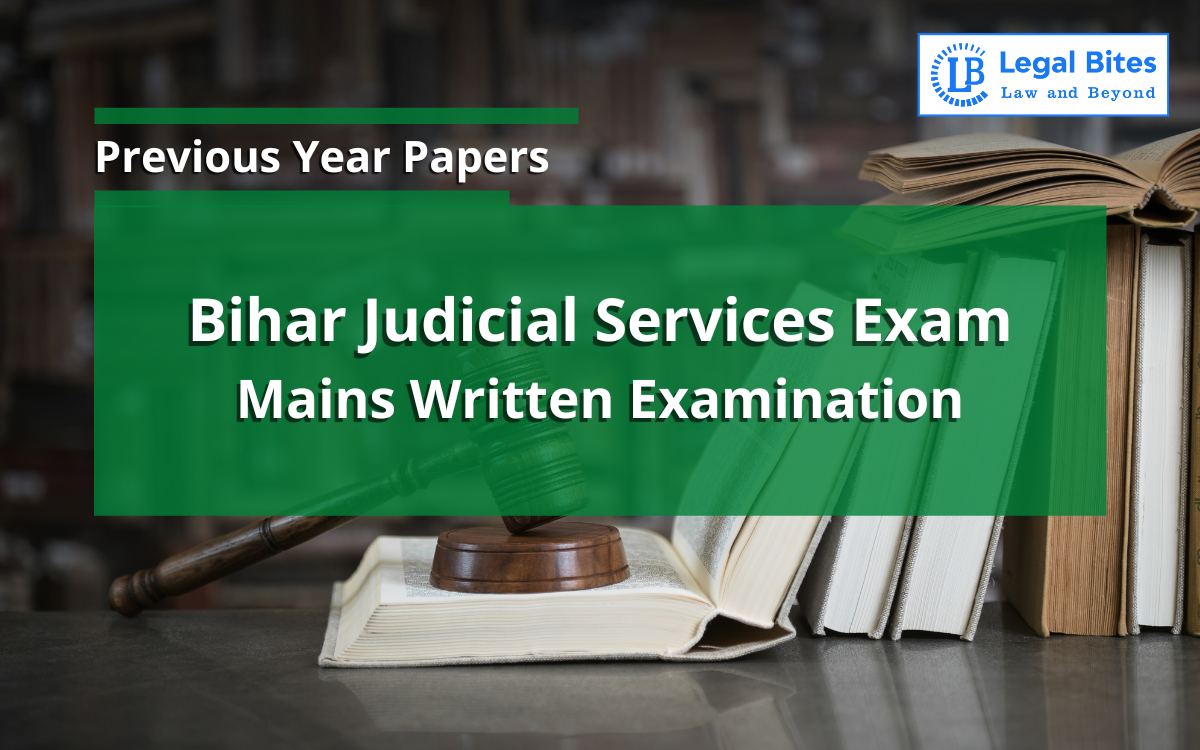Bihar Judicial Services Exam Mains 2023 Previous Year Paper (Commercial Law)
Candidates preparing for Bihar Judicial Services Exam should solve the Bihar Judicial Services Exam Mains 2023 (Commercial Law).

Candidates preparing for Bihar Judicial Services Exam should solve the Bihar Judicial Services Exam Mains 2023 (Commercial Law) and other previous year question papers before they face Prelims and Mains.
It also gives an idea about the syllabus and how to prepare the subjects by keeping the previous year's questions in mind. All toppers are mindful and cognizant of the types of questions asked by the BJS, to be aware of the various tricks and types of questions. This should be done by every aspirant when starting their preparation. It is very important to have an overall understanding of the pattern and design of questions.
Bihar Judicial Services Exam Mains 2023 Previous Year Paper (Commercial Law)
Only practising the authentic question papers will give you a real feel of the pattern and style of the questions. Here's Bihar Judicial Services Exam Mains 2023 Previous Year Paper (Commercial Law).
Bihar Judicial Services Mains Written Examination 2023
Commercial Law
Paper: Commercial Law
Time: 3 Hours
Maximum Marks: 150
Note: Marks are indicated against each question
Answer six questions, taking at least one from each Group.
Group - A
(Sale of Goods Act)
Question 1
(a) Define 'a contract of sale' of goods and discuss its essential elements. Make a distinction between 'sale' and 'agreement to sell'. (10+5=15 Marks)
(b) (i) X visited Y's garment shop and saw a placard stating "Buy one get one free". X bought a T-shirt for ₹ 500 and got another T-shirt for free. Whether the transaction is a sale or a gift? Give reasons. (5 Marks)
(ii) X contracted with Y (cloth merchant) for supply of cloth for packaging. Y supplied 'Hessian Cloth' (normally used for packing purposes). X found it unfit for his purpose (packaging foodstuffs) due to the smell inherent in the nature of cloth. Determine the liability of Y. (5 Marks)
Question 2
(a) Define the term 'goods'. Distinguish between specific and unascertained goods. State the rules regarding ascertainment of price in a contract of sale.
(5+5+5 = 15 Marks)
(b) A sells to B a scooter for a sum of ₹ 8,000. B pays the whole price except ₹ 1,000 which he promises to Pay within five days. A holds possession over the scooter until the rest of money is paid. But before the expiry of the stipulated time, B becomes insolvent. A resells the scooter to C for ₹ 8,500 without giving notice to B. B claims from A ₹ 500. i.e., profit on resale. Is A liable? Decide. (10 Marks)
Group - B
(Negotiable Instruments Act)
Question 3
(a) Define 'negotiable instrument'. Explain the law relating to the dishonour of cheque for insufficiency of funds in account with the help of decided cases and relevant statutory provisions. (5+10=15 Marks)
(b) Define 'promissory note' and 'bill of exchange', and make a distinction between them. (10 Marks)
Question 4
(a) Define the term 'endorsement'. What are the essentials for a valid endorsement? Explain various classes of endorsement. (5+5+5=15 Marks)
(b) Examine various modes of discharge from liability on negotiable instruments. (10 Marks)
Group - C
(Company Law)
Question 5
(a) Analyze the concept of lifting of the corporate veil with the help of statutory provisions and case laws. (15 Marks)
(b) Discuss the duties and liabilities of a promoter. (10 Marks)
Question 6
(a) Define 'share'. State different kinds of shares which a company may issue. What is a share warrant? (5+5+5=15 Marks)
(b) Discuss the law relating to the removal of Director of a company. (10 Marks)
Question 7
(a) Define private company. What are the privileges and exemptions available to a private company? (5+10=15 Marks)
(b) What are the duties and powers of tribunal with respect to the reconstruction and amalgamation of the company? (10 Marks)
Group - D
(Indian Partnership Act, 1932)
Question 8
(a) State the essential elements which are necessary for the formation of a partnership. How would you distinguish a partnership from joint Hindu family business and co-ownership? [5+(5+5)=15 Marks]
(b) A carries on in his name the business of loading and unloading wagons of a limited company. A appoints B to manage the business. It is agreed between them that B shall get 60% share out of the net profits as remuneration and that A shall get only 40% share but shall not be liable for loss. Are A and B partners? Give your answer with reasons and supported by case laws on the point. (10 Marks)
Question 9
(a) What do you understand by 'doctrine of holding out'? Explain. Discuss its exceptions. (15 Marks)
(b) Examine the legal and statutory framework for admission and retirement of partners under the Partnership Act. (5+5=10 Marks)
Question 10
(a) Is registration of a partnership firm compulsory under the Indian Partnership Act, 1932? State the effects of non-registration. State the procedure prescribed for registration of firms. (5+5+5=15 Marks)
(b) Explain various modes of dissolution of a partnership firm along with the consequences of dissolution thereof. (5+5=10 Marks)

